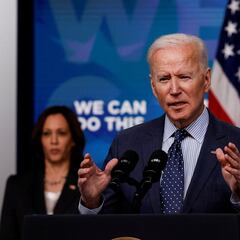How has the US unemployment rate changed during the Biden presidency and since the start of the covid-19 outbreak?
The latest figures show that the US jobs market continued to grow in May but failed to meet predictions. How has the pandemic affected the national unemployment rate?


On Friday the Labor Department reported new jobs figures which show that the US employers added 559,000 workers during May, falling short of predictions.
However there was some good news for President Biden as the unemployment rate dropped to 5.9%. Job growth has been fluctuating in recent months but as the vaccination effort continues and businesses are able to reopen there is optimism that the US is on the road to recovery.
Carl R. Tannenbaum, chief economist for Northern Trust, said of today’s news: “We’re making good progress to getting back to full employment,” adding, “but it will be a number of months before we reach that goal.”
How has the unemployment rate changed since Biden took office?
One of Biden’s main goals when entering the White House was to get the US economy back on track, but he has faced an uphill battle so far. May’s job report followed another set of slightly underwhelming figures from April which showed only modest growth.
"Quite frankly, we're moving more rapidly than I thought we would," Biden explained at the time. He added that his American Rescue Plan, the $1.9 trillion coronavirus relief bill, “was designed to help us over the course of a year.”
Today’s latest jobs report shows we are continuing to experience a record economic recovery, with record job growth and record wages. Since the President was sworn in, our economy has created 540,000 jobs on average monthly. Read more: https://t.co/qrMeBAiblY
— The White House (@WhiteHouse) June 4, 2021
The latest unemployment rate of 5.9% is lower than the figure of 6.3% when he took office, but the speed of improvement does appear to have plateaued in recent months.
How has the jobs market been affected by the pandemic?
In February 2020 the US unemployment rate stood at 3.5%, and had been fairly stable in the months leading up to the pandemic. However when covid-19 really began to take its toll on the economy in spring of last year the unemployment rate sky-rocketed as businesses were shuttered and forced to lay off workers.
By April the unemployment rate had peaked at 14.8%, the highest rate since the US Bureau of Labor Statistics began recording the data in 1948. Although the jobs market began to bounce back the month after, the impact of that initial spike is still keenly felt in most sectors and leaves the US jobs level roughly seven million shy of the pre-pandemic figure.
Pres. Biden celebrates jobs report: ‘This is progress, historic progress, progress that’s pulling our economy out of the worst crisis it’s been in in 100 years.’ pic.twitter.com/QMagVCNeg5
— NowThis (@nowthisnews) June 4, 2021
One positive for Biden to take from the long-term jobs figures is an acceleration in wage gains, which have grown by 2% year on year.
Related stories
Yung-Yu Ma, chief investment strategist at BMO Wealth Management, praised the Federal Reserve for its more cautious policy and said the report showed "a decent number, a relatively solid rebound and strengthening economy but one that still allows the Fed to take it a little bit slower.”
He added: “The jobs market is tight, but I don’t think we’re close to full employment.”

